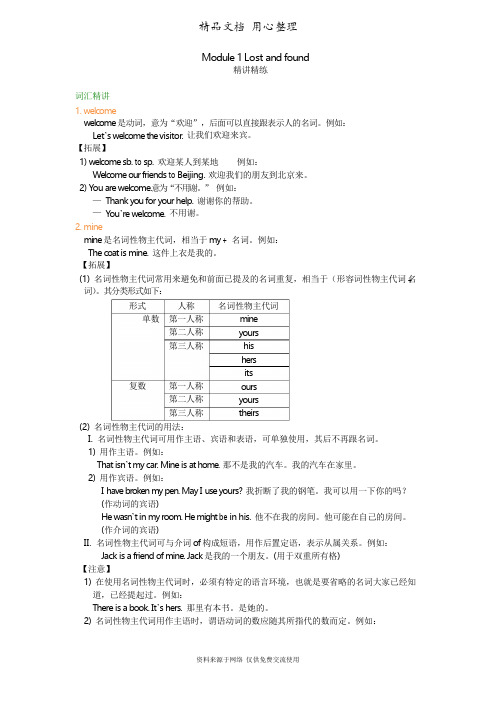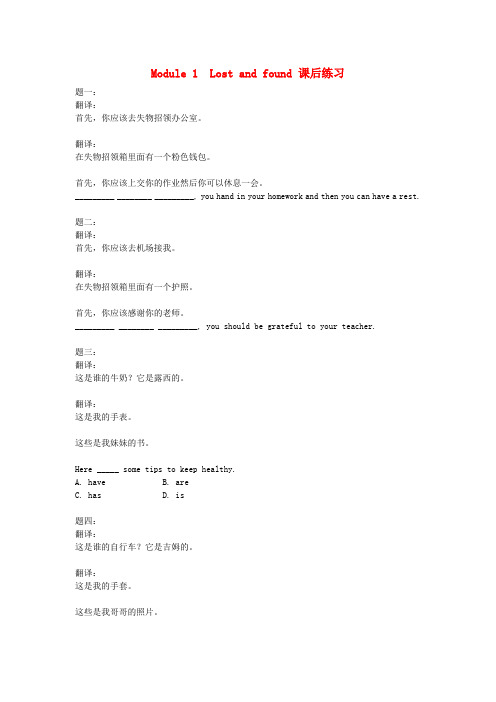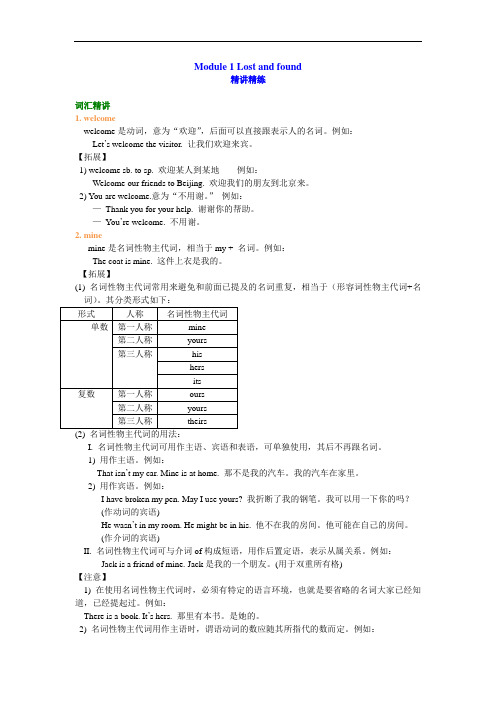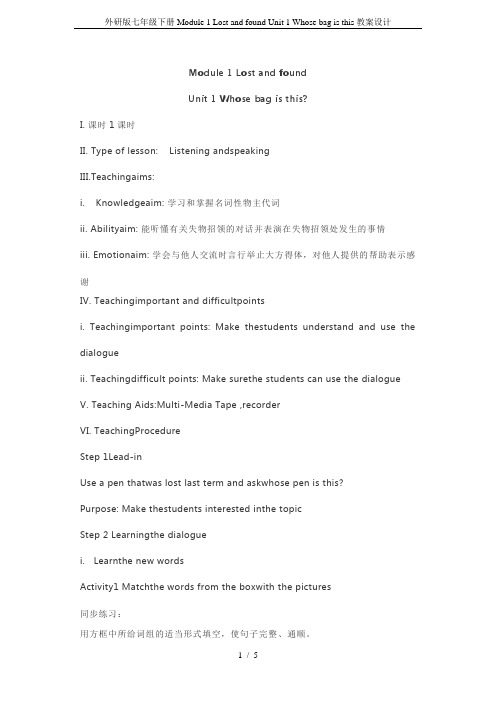外研版七年级英语下册学生版 Module 1 Lost and found专题讲解及习题
- 格式:doc
- 大小:44.55 KB
- 文档页数:5

+ Module 1 Lost and found精讲精练词汇精讲1. welcomewelcome 是动词,意为“欢迎”,后面可以直接跟表示人的名词。
例如:Let ’s welcome the visitor . 让我们欢迎来宾。
【拓展】1) welcome sb. to sp. 欢迎某人到某地 例如:W elcome our friends to Beijing. 欢迎我们的朋友到北京来。
2) Y ou are welcome.意为“不用谢。
” 例如:— Thank you for your help. 谢谢你的帮助。
— Y ou ’re welcome. 不用谢。
2. minemine 是名词性物主代词,相当于 my + 名词。
例如:The coat is mine. 这件上衣是我的。
【拓展】(1) 名词性物主代词常用来避免和前面已提及的名词重复,相当于(形容词性物主代词 名 词)。
其分类形式如下:形式 人称单数 第一人称 第二人称第三人称复数 第一人称第二人称 第三人称 名词性物主代词 mine yours his hers its oursyours theirs(2) 名词性物主代词的用法:I. 名词性物主代词可用作主语、宾语和表语,可单独使用,其后不再跟名词。
1) 用作主语。
例如:That isn ’t my car . Mine is at home. 那不是我的汽车。
我的汽车在家里。
2) 用作宾语。
例如:I have brok en my pen. May I use yours? 我折断了我的钢笔。
我可以用一下你的吗? (作动词的宾语)He wasn ’t in my room. He might be in his. 他不在我的房间。
他可能在自己的房间。
(作介词的宾语)II. 名词性物主代词可与介词 of 构成短语,用作后置定语,表示从属关系。
例如:Jack is a friend of mine. Jack 是我的一个朋友。

Module 1 Lost and found 课后练习题一:翻译:首先,你应该去失物招领办公室。
翻译:在失物招领箱里面有一个粉色钱包。
首先,你应该上交你的作业然后你可以休息一会。
_________ ________ _________, you hand in your homework and then you can have a rest.题二:翻译:首先,你应该去机场接我。
翻译:在失物招领箱里面有一个护照。
首先,你应该感谢你的老师。
_________ ________ _________, you should be grateful to your teacher.题三:翻译:这是谁的牛奶?它是露西的。
翻译:这是我的手表。
这些是我妹妹的书。
Here _____ some tips to keep healthy.A. haveB. areC. hasD. is题四:翻译:这是谁的自行车?它是吉姆的。
翻译:这是我的手套。
这些是我哥哥的照片。
Here _____ some nice watches. Do you want to buy one?A. beB. areC. amD. is题五:翻译:快点,否则你不能赶上火车。
If you don’t get to the school ___ a hurry, you will be late.A. forB. withC. atD. in题六:翻译:快点,否则你就会落后其它学生。
Our English teacher left our classroom ______ a hurry.A. byB. withC. atD. in题七:翻译:我经常把手机忘在家里。
I often ______ my homework at home.A. forgetB. forgetsC. leaveD. leaves题八:翻译:有些人经常把东西忘在火车上。

Module 1 Lost and found精讲精练词汇精讲1. welcomewelcome是动词,意为“欢迎”,后面可以直接跟表示人的名词。
例如:Let’s welcome the visitor. 让我们欢迎来宾。
【拓展】1) welcome sb. to sp. 欢迎某人到某地例如:Welcome our friends to Beijing. 欢迎我们的朋友到北京来。
2) You are welcome.意为“不用谢。
”例如:—Thank you for your help. 谢谢你的帮助。
—You’re welcome. 不用谢。
2. minemine是名词性物主代词,相当于my + 名词。
例如:The coat is mine. 这件上衣是我的。
【拓展】(1) 名词性物主代词常用来避免和前面已提及的名词重复,相当于(形容词性物主代词+名词)。
其分类形式如下:I. 名词性物主代词可用作主语、宾语和表语,可单独使用,其后不再跟名词。
1) 用作主语。
例如:That isn’t my car. Mine is at home. 那不是我的汽车。
我的汽车在家里。
2) 用作宾语。
例如:I have broken my pen. May I use yours? 我折断了我的钢笔。
我可以用一下你的吗?(作动词的宾语)He wasn’t in my room. He might be in his. 他不在我的房间。
他可能在自己的房间。
(作介词的宾语)II. 名词性物主代词可与介词of构成短语,用作后置定语,表示从属关系。
例如:Jack is a friend of mine. Jack是我的一个朋友。
(用于双重所有格)【注意】1) 在使用名词性物主代词时,必须有特定的语言环境,也就是要省略的名词大家已经知道,已经提起过。
例如:There is a book. It’s hers. 那里有本书。

外研版七年级下册英语第一模块《M1. Lost andfound 》重要知识点总结M1U1 :(1)lose 的过去式、过去分词都为lostfind 过去式、过去分词都为foundlost and found box/office 失物招领箱/ 处常见用法:lose things/face/confidence(信心)be/get lost 迷路(2)an eraser 一块橡皮(3)two pairsof gloves 两副手套(4)Welcome (动词)(back) to sp. ... 欢迎(返)回某地welcome 后接副词home/here/there 等时,不加介词toeg. Welcome (动词)home.You 're always welcome(形容词) at our house. 随时都欢迎你到我们家。
They gave us a warm welcome(名词)。
他们给予我们热烈的欢迎。
(5)first of all 首先,强调顺序; above all 首先,最重要的是,强调重要性。
(6)look(动词) at=have a look(名词) at 看一下(7)I think (省略了起连接作用却没有词义的that) it 's Betty 's.该句为宾语从句,相当于in my opinion.(9)be careful with sth “小心(对待)/保管某物”be careful of/about sb./sth. “小心/当心某人/物”be careful (not) to do sth. “小心(不)做某事”(10)from now/then/1982 on 从现在/那时/1982 年开始(9)Here be(is/are)... “...... 在这”,be 动词遵循语法的“就近原则” ,同there be 句型。
eg.S1.Here isan eraser. S2.Here aretwo purple wallets.M1U2 :(1)at the lost and found office 在失物招领处(2)look for 有目的地寻找,强调动作&find 强调结果,意为“找到” 。

七下(外研版)Module 1 知识点总结一、必背短语welcome back first of all lost and found box a lot of things 欢迎回到首先失物招领箱许多东西be careful with from now on here is/ are let sb do sth 小心对待从现在起这里有让某人做某事get on in a hurry leave sth somewhere that’s why上(车,船等)匆忙地把某物落在某地那是…的原因hundreds of look for at the moment play the piano 成百上千的寻找现在,此刻弹钢琴ride a bike on the board would like to do sth that’s all 骑自行车在布告上想要做某事仅此而已what about you? w hat about/how about doing sth join…club 你呢?做某事怎么样加入俱乐部worry about担心二、必背句子1.Welcome back to school. Come and look in the lost and found box.欢迎回到学校。
首先来看看这个失物招领箱。
2.There are a lot of things in it.里面有许多东西。
3.Whose bag is this?这个袋子是谁的?4.Here is a purple wallet.这里有个紫色的钱包。
5. Please be careful with your things from now on.从现在起请你们小心对待自己的东西。
6. People often lose things when they’re travelling or when they’re in a hurry. 人们在旅游或匆匆忙忙时经常丢东西。

Module 1 Lost and foundUnit 1 Whose bag is this?I. 课时1课时II. Type of lesson: Listening andspeakingIII.Teachingaims:i. Knowledgeaim: 学习和掌握名词性物主代词ii. Abilityaim: 能听懂有关失物招领的对话并表演在失物招领处发生的事情iii. Emotionaim: 学会与他人交流时言行举止大方得体,对他人提供的帮助表示感谢IV. Teachingimportant and difficultpointsi. Teachingimportant points: Make thestudents understand and use the dialogueii. Teachingdifficult points: Make surethe students can use the dialogue V. Teaching Aids:Multi-Media Tape ,recorderVI. TeachingProcedureStep 1Lead-inUse a pen thatwas lost last term and askwhose pen is this?Purpose: Make thestudents interested inthe topicStep 2 Learningthe dialoguei. Learnthe new wordsActivity1 Matchthe words from the boxwith the pictures同步练习:用方框中所给词组的适当形式填空,使句子完整、通顺。
1. –How much isthe book?--20 yuan.--___ the money.2. ______, finishyour homework after youget home.3. Everyone,please ____ your things whenyou take a bus.4. I’m your newEnglish teacher _______.5. Everyone,please ______ the pictures______ the right thingsii. Listen andreadListen to thetape and read the dialogueiii. Match thepeople with the thingsiv. Explain thelanguage pointsMs Li: Welcomeback to school, everyone!First of all, come and look in the lost and foundbox! There are a lot of thingsin it. Whose bag is this? Lingling: Ohsorry! It’s mine. Are my crayonsthere too?Ms Li: Are thesecrayons yours?Lingling: Yes,they are and this erasertoo. Thank you.Ms Li: Whosetapes are these?Daming: They’remine.Ms Li: Here’spurple wallet!Tony: It’s mine.Look! Here’s myname “Tony”! Thank you.Ms Li: You’rewelcome! Look at this nice watch. Is ityours too, Daming?Daming: No, itisn’t. I think it’s Betty’s.Lingling: Yes, it’shers.Ms Li: Everyone,please be careful withyour things from now on. Daming: Here aresome nice gloves. Whosegloves are they?Ms Li: Let mesee. …Oh, they’re mine. Thank you!v. Activity 4 andactivity 5Step 3 Making thedialogue (Activity 7)Work in groups ofthree, put four or fiveschool things on the desk, ask and answer.Step 4PronunciationStep 5 Sum up andexercise1. --________ carin front of the officeis it?--I think it’s Mr Green’s. He drives the carto work every day.A.WhoB.WhoseC. HowD.What2. –What is thetime now?--Let me look at my ___.Oh, it’s nine o’clock.A.numberB.planC.watchD. camera3. –Is this yourEnglish book, Amy?--No. ____ is in myschoolbag.A.MineB. MyC. MeD. I4. –How can westay healthy?-- ___, we should eathealthy food and takeexercise every day.A. AswellasB. First of allC. At themomentD. Ina minute5. –Mike, here ____some letters for you.--Thank you. They arefrom my American penfriend John.A.isB.beC.areD. were6. Where isSimon? His mother is ____ himnow.A.lookingatB. lookingforC.findingD. finding out7. When you _____things, you can go tothe Lost and Found Office in our city.A.loseB. buyC.getD. sell8. –David, isthis your sister’s doll?-- Yes, it’s ___. She plays withit everyday.A.herB. hisC.hersD. sheStep 6: HomeworkVII. BlackboardwritingModule 1 Lost and foundUnit 1 Whose bag is this?whose firstofall my minelose lostand found box our oursfind becareful with your yoursfrom now on your yourshereis/are her hershis his its its heir theirs VIII. 反思。
Module1 Lost and found 专题讲解一、本单元提纲1.主题功能:能够谈论物品和物品的主人。
2.重点单词:camera, crayon, airport, phone, leave等。
3.重点词组:first of all, lost and found box, from now on, in the hurry 等。
4.重点句型:Whose bag is this? Oh sorry! It’ s mine.Are these crayons yours? Here’s a purple wallet.二、核心语法:名词性物主代词三、重难点精讲1. First of all, come and look in the lost and found box.首先, 过来看看失物招领箱吧。
▲first of all 意思是“首先”, 和at the beginning意思相同。
首先,你应该向他道歉。
______, _____, ______, you should say sorry to him.2. Whose bag is this? Oh sorry! It’s mine.▲问句是whose引导的特殊疑问句,whose意为“谁的”。
Here _____ some ways to learn English.A. haveB. hasC. areD. is3. Everyone, please be careful with your things from now on.▲be careful with意思是“小心(对待)......”。
▲CARE的派生词:careful,carefully,careless,carelessly.▲from now on意思是“从现在开始”。
4. People often lose t hings when they’re traveling or when they’re in a hurry.▲in a hurry意思是“匆匆忙忙”。
hurry还可以做动词,hurry up意思是“赶快点,赶紧”。
If you d on’t get to the station ___ a hurry, maybe you can’t catch the train.A. forB. inC. atD. with5. They leave things on planes, on trains, on buses, and in taxis.他们把物品遗忘在飞机,火车,公共汽车以及出租车上。
▲leave是动词,意思是“遗忘, 丢下”。
注意:表示“把某物遗忘在某处”时,不能用forget, 只能用leave.I didn’t turn in my homework because I ______ it at homeA. rememberedB. forgotC. leftD. left for6. That’s why there are lost and found offices at airports and stations.这就是在机场和车站有失物招领办公室的原因。
▲That’s why.....意思是“这就是....的原因”。
7. Hundreds of people come here everyday.每天都有许多人到这里来。
▲Hundreds of是固定搭配,意思是“好几百,许许多多”,当hundred前有具体的数词时,要用hundred的单数形式,而且不和of连用。
和hundred用法一样的词还有thousand,million等。
thousand of 数以千计的,成千上万的millions of 数以百万计的____soldiers and doct ors went to Ya’an to help the people there two months ago.A. Thousands ofB. Two thousandsC. Thousand ofD. Two thousands of8. They are looking for their phones, cameras, watches, computers and many other things.他们正在寻找他们的电话,相机,手表,电脑和许多其他的东西。
▲look for意思是“寻找”,强调“找”的动作,是look的常见搭配。
find意思是“找到”,强调“找”的结果。
He ____ his bike, but he can’t ____ it.A. look for; findsB. looks for; findsC. finds; look forD. looks for; find look短语:look at看look for寻找look after照顾look up查阅look around向四周看look out 向外看、当心9. They can help you find them.他们能帮你找到它们。
▲help sb. do sth.意思是“帮助某人做某事”,它与help sb.to do sth和help sb.with sth.是同义表达。
综合测试(Module 1)Ⅰ. 单项选择1. This is ______ key and that is ______ eraser.A. a; aB. a; anC. an; aD. an; an2. —_______ is this pen? —It’s mine.A. WhatB. WhoseC. WhereD. How3. Every year, ______ people go to visit the factory.A. a thousand of B thousands C. thousand of D. thousands of4. —Here is a schoolbag. Whose is it? —Oh, it’s _______. Thank you.A. myB. mineC. meD. I5. — Is this ______ ruler? —No. _______ is over there.A. her; HerB. her; HersC. hers; HersD. hers; Her6. Please be ______ with your key. Don’t lose it again.A. careB. carefulC. carelessD. caring7. Can you see my wallet? I can’t ______ it now.A. findB. foundC. look forD. look at8. —Is this yellow schoolbag Tom’s?—No, it isn’t. ______ is black.A. MineB. HisC. HersD. Yours9. Is this ______ watch? Call Jim ______ 458-6458.A. your; atB. you; atC. your; inD. you; in10. My brother often hurries ______ breakfast in the morning.A. haveB. hasC. to haveD. having11.------Mike, is that new bike_____?------Yes. My mother bought it for me yesterday.A. youB. yourC. yoursD. yourself12. These are ____erasers, and ____ are white.A. my, yourB. my, yoursC. mine, yourD. mine, yours13. The _____ shoes are dirty, so they must take them off before they go into ____house.A. boys’; John’sB. boys’; Johns’C. boy’s; Johns’D. boy’s; John’s14. —I can’t find my eraser.—Is the one on Jack’s desk______?—Yes, thank you.A. hisB. yoursC. oursD. mine15. —What’s on the desk? —There______some books and a bag.A. beB. areC. isD. am16. Look! The boys______ football on the playground.A. playsB. playC. are playingD. playing17. Can I use ______ English book? ______ isn’t here.A. your; IB. you; MyC. yours; MineD. your; MineⅢ. 阅读理解FoundIs this your watch?It’s a yellow wa tch.Please call Paul at 439-9175.LostMy backpack.It is blue with a duck on it. Please call Linda. Phone 416-3592.FoundIs this your English-Chinese dictionary? It’s red. It’s under my desk.Please call Alan at 485 -7700.LostMy school ID card. My name is Jim.Please call 465-0921.1. If you ______, you can call Alan.A. lose your watchB. find a backpackC. lose your dictionaryD. find a school ID card2. What colour is the backpack?A. It’s blue.B. It’s yellow.C. It’s re d.D. It’s black.3. If you find a school ID card, you can call______.A. 439-9175B. 416-3592C. 485-7700D. 465-09214. Which of the following is TRUE according to the ad?A. Paul found a white watch.B. Linda found a backpack with a duck on it.C. Alan found an English-Chinese dictionary.D. Jim found a school ID card.5. If the ad is in the newspaper, the name of the topic will probably be______.A. Lost and FoundB. Everyday NewspaperC. Love StoryD. Travel AroundIV. 改写句子1. That is Lisa’s notebook.(对划线部分提问) _________, _________ is that?2. I help him learn English.(改为同义句) I help him ____________ English.3. They take the train to the town.(改为同义句)They go to the town __________, _________.4. These are Jack’s books.(改为一般疑问句)________, _________ Jack’s books?5. My brother likes swimming because it can make him strong.(对划线部分提问) _________, __________ your brother __________ swimming?Whose notebook; with; by train; Are these; Why does...likeⅤ. 用括号内所给单词的适当形式填空1. My pen is _________ (lose). I am looking for it.2. My sweater is green. __________ (she) is yellow.3. I have __________ (hundred) of storybooks in my study.4. —Whose __________ (pig) are those? —They’re Lily’s.5. This wallet isn’t mine. It’s __________ (Daming).Ⅵ. 根据句意及汉语提示写单词1. —Whose __________ (手套) are these? —They’re Jane’s.2. Mr Wang is going to the ___________ (机场) .3. Let’s buy a new __________ (照相机).4. How many ____________ (鸭) are there in the lake?5. There are three ___________ (千) students in our school.6. —Can I use your green c_________? I want to draw a tree.7. Be c___________! The knife(小刀) may cut your finger(手指).8. Whose w__________ is it? There is a lot of money (钱)in it.9. Where are my gloves? I can’t f__________ them.10. —Your p__________ dress is very beautiful on you.—Thank you. It’s my favourite colour.Ⅶ. 根据汉语提示完成句子,每空一词1. 从现在起你就是一名学生了。